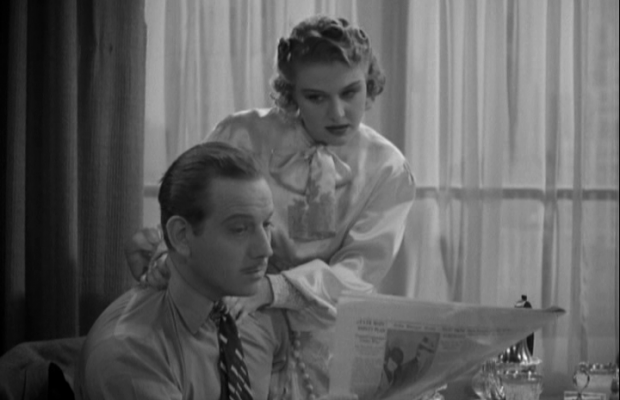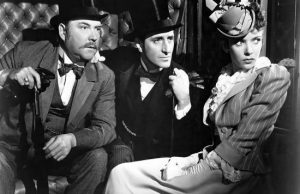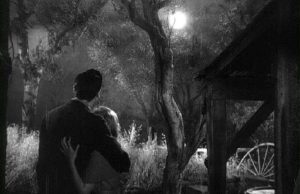Fast Company (1938)

Toronto Film Society presented Fast Company (1938) on Monday, August 22, 2016 in a double bill with The League of Gentlemen as part of the Season 69 Summer Series, Programme 6.
Production Company: Metro-Goldwyn-Mayer. Director: Edward Buzzell. Producer: Frederick Stephani. Book: Harry Kurnitz (as Marco Page). Screenplay: Harry Kurnitz (as Marco Page) and Harold Tarshis. Cinematography: Clyde De Vinna. Music: William Axt. Film Editing: Fredrick Y. Smith. Art Direction: Cedric Gibbons. Costumes: Dolly Tree.
Cast: Melvyn Douglas (Joel Sloane), Florence Rice (Garda Sloane), Claire Dodd (Julia Thorne), Shepperd Strudwick (Ned Morgan), Louis Calhern (Elias Z. “Eli” Bannerman), Nat Pendleton (Paul Terison), Douglass Dumbrille (Arnold Stamper), Mary Howard (Leah Brockler), George Zucco (Otto Brockler), Minor Watson (Steve Langner), Donald Douglas (Lt. James Flanner), Dwight Frye (Sidney Z. Wheeler), Thurston Hall (Dist. Atty. MacMillen), Horace McMahon (Danny Scolado).
Fast Company is based on a mystery novel by Marco Page. Page was the pseudonym for American playwright, novelist and screenwriter Harry Kurnitz who wrote comedies for Danny Kaye, two Thin Man stories and one screenplay, as well as collaborated with Billy Wilder on the screenplay for Witness for the Prosecution. Although he wasn’t a writer for the Song of the Thin Man which we screened on August 8th, a connection is that tonight’s director, Edward Buzzell, was the director of that film too.
Fast Company was definitely influenced by The Thin Man. Both involve a married couple who exchange witty dialogue and become involved in a murder investigation. The main difference between these four people is that tonight’s couple, Joel and Garda Sloane, are no match for Nick and Nora when it comes to enjoying alcoholic beverages.
In Ron Backer’s Mystery Movie Series of 1930s Hollywood, he writes that Fast Company may have more fascinating male villains played by some of our favourite character actors than in any other movie. George Zucco plays Otto Brockler, a rotter who deals in stolen books and has apparently framed an innocent man into a two-year-prison term, despite the protests of Brockler’s own daughter. Louis Calhern plays Elias Bannerman, a low-down chiseler, who will stop at absolutely nothing, including murder, to get what he wants. Dwight Frye plays Sidney Wheeler, Bannerman’s assistant, and Nat Pendleton plays hit man Paul Terison.
The one female exception is the underrated and lovely Claire Dodd, who plays Brockler’s secretary, Julia Thorne. Her role is partially written as a blond femme fatale, one of the first, as that specialized character only became fully developed once film noir came into being in the 40s. Backer writes that, “While Julia is far from honest and is not above using her feminine wiles for criminal gain, Dodd, while attractive, exudes no sensuality in the role. Joel Sloane seems to be half-heartedly romancing Julia and Julia seems to be half-heartedly romancing Joel, while at the same time reluctantly romancing Bannerman. With a part that is so ambiguously and inconsistently written, it is not surprising that Dodd’s performance is weak.”
The film’s dialogue is every bit as clever as that in The Thin Man movies, with Melvyn Douglas’s performance coming close in suaveness to that of William Powell’s. Florence Rice is very appealing although she is not quite as tantalizing as Myrna Loy was in the early Thin Man films—as she was in most other films, in my opinion.
Since Marco Page wrote both the novel and the screenplay, there are still a few differences between the two. A few subsidiary characters are not carried over into the film, the plight of Ned Morgan and Julia Thorne receive more prominence in the film, as does Garda and her relationship with her husband, Joel. Besides using most of the clever dialogue included from the novel, additional repartee between the spouses was added into the screenplay. The finale was tightened up which made the film more suspenseful than the novel, making the film superior to the book, which is usually not the case.
Caren Feldman
Caren’s Classic Cinema
Made in 1938, directed by Edward Buzzell, it was the first of three movies featuring the characters Joel and Garda Sloane, rare book dealers and amateur sleuths. Two other films, Fast and Loose and Fast and Furious followed in 1939. In Fast Company, Melvyn Douglas and Florence Rice portray Joel and Garda Sloan. In this outing, the Sloans are out to solve the murder of a shady rare book dealer. There is a terrific supporting cast, including Dwight Frye, Nat Pendleton, Louis Calhern, Horace McMahon, Claire Dodd and Canadian-born Douglass Dumbrille.
Douglass Dumbrille was born in Hamilton, Ontario in 1889. He was employed as a bank clerk in Hamilton while pursuing an interest in acting. He left his bank job and worked with various stock companies touring the United States. In 1913, he appeared in the film What Eighty Million Women Want. He didn’t appear in another film until 1924, but worked on Broadway and supplemented his income selling insurance, car parts and other things. He went to Hollywood in the early years of the Great Depression and became a sought after character actor. He was a favourite of Frank Capra, Cecil B. DeMille and other top directors of the day. He excelled at playing unlikable characters. Who can forget him as “the twitcher” in Mr. Deeds Goes to Town or the sleazy banker in the Marx Brothers movie A Day at the Races. Dumbrille had a long career playing crooked politicians, unscrupulous lawyers and other unlikable authority figures. He was the foil of the Marx Brothers, Hope and Crosby, Abbott and Costello and the Bowery Boys, among so many others. He guest-starred in a number of television shows, including Perry Mason and even Batman in 1966.
He was married to his first wife, Jessie Lawson, for 48 years, until her death in 1958. In 1960, at age 70, he married Patricia Mowbray, the 28-year-old daughter of his good friend, actor Alan Mowbray. He was criticized for the age difference, but gave a terrific response to his detractors. He said, “Age doesn’t mean a blasted thing. The important thing is whether two people can be happy together. Pat and I agreed that I had some years left and we could best share them together. We don’t give a continental damn what other people think.” He died of a heart attack on April 2, 1974 at his home in Woodland Hills, California. He was 84.
Notes by Bruce Whittaker












Leave a Reply